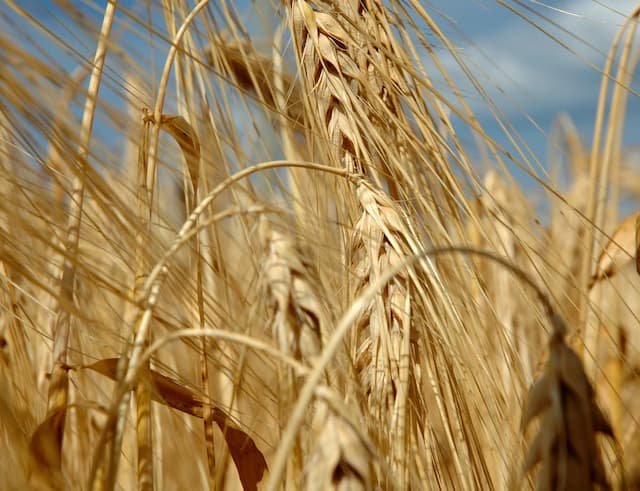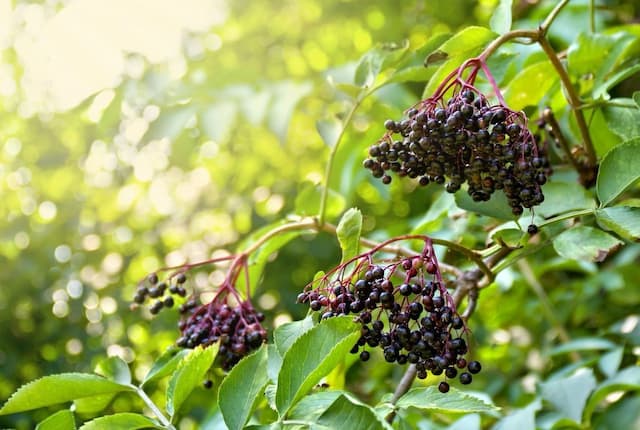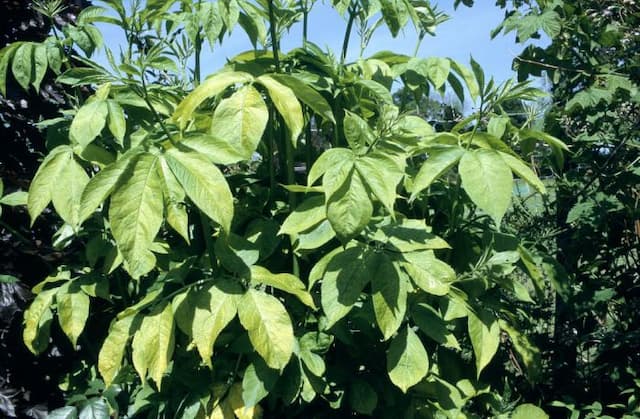Golden Elderberry Sambucus racemosa 'Plumosa Aurea'

ABOUT
The plant known as 'Plumosa Aurea' is a visually striking variety of the Elderberry. It stands out with its uniquely colored foliage, which displays various shades of golden yellow. The leaves of this variety are finely dissected, giving them a feathery appearance. This intricate texture lends an airy and graceful feel to the plant. In contrast to the bright foliage, the stems are often a reddish hue, creating a beautiful contrast that can catch the eye. During the blooming season, 'Plumosa Aurea' produces clusters of small, creamy-white flowers that emerge in rounded groups. These flower clusters provide a soft, yet noticeable visual interest and can attract pollinators such as bees and butterflies. Following the flowers, if pollinated, the plant may produce clusters of small, red to dark purple berries. As the seasons change, the golden foliage can transform, taking on deeper tones of orange and bronze, adding a warm, autumnal flare to the plant's appearance. These colorful leaves can make 'Plumosa Aurea' a stunning addition to any garden, both for its vibrant spring and summer foliage and its rich autumn hues.
About this plant
 Names
NamesFamily
Adoxaceae.
Synonyms
Golden Elderberry, Red Elderberry 'Plumosa Aurea', Cutleaf Elderberry, Fernleaf Elderberry.
Common names
Sambucus racemosa 'Plumosa Aurea'.
 Toxicity
ToxicityTo humans
The Red Elderberry is considered poisonous to humans. All parts of the plant including leaves, stems, roots, and unripe fruits contain cyanogenic glycosides, which can release cyanide when ingested. Ingestion can lead to a variety of symptoms such as nausea, vomiting, abdominal cramps, diarrhea, and weakness. In severe cases, toxicity may lead to difficulty in breathing, dizziness, and can even be life-threatening if a sufficient amount is ingested.
To pets
Red Elderberry is also toxic to pets. Similar to humans, the consumption of leaves, stems, roots, or unripe berries of this plant by pets can lead to the release of cyanide in their bodies. Symptoms of poisoning in pets can include vomiting, diarrhea, abdominal pain, weakness, and lethargy. In severe cases, ingestion can result in seizures, coma, and can be fatal if a large enough quantity is consumed and not treated promptly.
 Characteristics
CharacteristicsLife cycle
Perennials
Foliage type
Deciduous
Color of leaves
Variegated
Flower color
White
Height
6-10 feet (1.8-3 meters)
Spread
6-10 feet (1.8-3 meters)
Plant type
Shrub
Hardiness zones
3-7
Native area
Europe
Benefits
 General Benefits
General Benefits- Ornamental Value: The Sambucus racemosa 'Plumosa Aurea', commonly known as the European red elder, has attractive golden-yellow foliage and lacy leaves, making it a striking addition to gardens.
- Wildlife Attraction: This plant offers nectar-rich flowers that are appealing to pollinators such as bees and butterflies, enhancing biodiversity.
- Shade Tolerance: The European red elder is tolerant of partial shade, allowing it to thrive in a variety of lighting conditions within a landscape.
- Easy Propagation: It can be easily propagated by softwood cuttings, making it simple for gardeners to expand their plantings or share with others.
- Versatility in Landscaping: The plant can be used in mixed borders, as a specimen plant, or in wild gardens, providing flexibility in design.
- Seasonal Interest: With flowers in the spring and berries in the summer, the European red elder offers multi-seasonal interest.
- Fast Growth: This shrub is known for its rapid growth rate, quickly establishing itself in the landscape and reaching its full ornamental potential.
 Medical Properties
Medical Properties- Immune System Support: The elderberry species, including Sambucus racemosa, is traditionally used for its potential to boost the immune system, particularly in fighting colds and flu.
- Respiratory Health: Elderberries have been used to help alleviate symptoms of respiratory conditions, possibly due to their expectorant properties.
- Antioxidant Properties: This plant is known to contain antioxidants that may help protect cells from damage by free radicals.
- Anti-inflammatory Effects: Compounds in elderberries may have anti-inflammatory properties, which can be beneficial in reducing inflammation in the body.
- Diuretic Potential: Elder has been used traditionally as a diuretic, helping to remove excess fluids from the body.
- Antiviral Activity: Some studies suggest that elderberry may have antiviral properties, which can help in the treatment of viral infections.
 Air-purifying Qualities
Air-purifying QualitiesThis plant is not specifically known for air purifying qualities.
 Other Uses
Other Uses- Ornamental Dye: The berries of the Elderberry can be used to create natural dyes for fabrics, offering a range of colors from blues to purples depending on the mordant used.
- Elderberry Ink: The juice from its berries can be boiled down with a fixative to create homemade botanical ink, popular for calligraphy and art purposes.
- Garden Border Planting: Elderberry 'Plumosa Aurea' can serve as a vibrant, textured border in garden design, with its striking golden leaves adding aesthetic value throughout the season.
- Photography Subject: The plant, with its intricate leaves and flowers, has become a favorite among photographers looking to capture the essence of spring and summer gardens.
- Floral Arrangements: Fresh or dried flowers from the Elderberry are sometimes used in floral arrangements to provide a rustic or wildflower look.
- Fruit Vinegars: The berries can be used to create flavored vinegars, which impart a fruity taste to salad dressings and marinades.
- Leaf Castings: Leaves of 'Plumosa Aurea' can be used in the art of leaf casting, where they are pressed into a medium to create decorative impressions that capture their unique texture and shape.
- Bee and Butterfly Attraction: Planting Elderberry in gardens can serve as an eco-friendly means to attract pollinators such as bees and butterflies, which is beneficial for maintaining healthy and biodiverse local ecosystems.
- Culinary Garnish: While not a common practice, the flowers can be used to add an ornate garnish to desserts or drinks when in bloom, provided they are used sparingly and identified as safe and non-toxic.
- Wildlife Habitat: The dense foliage of Elderberry provides excellent cover for birds and small mammals, supporting wildlife and promoting biodiversity.
Interesting Facts
 Feng Shui
Feng ShuiThe Red Elderberry is not used in Feng Shui practice.
 Zodiac Sign Compitability
Zodiac Sign CompitabilityThe Red Elderberry is not used in astrology practice.
 Plant Symbolism
Plant Symbolism- Protection: Sambucus racemosa, commonly known as red elderberry, has traditionally been used to ward off negative energy and provide protection due to its strong fragrance and medicinal properties.
- Healing: The elderberry is known for its medicinal benefits, representing healing and good health.
- Transformation: The plant's ability to grow quickly and adapt to different environments symbolizes transformation and adaptability.
- Prosperity: Elderberry can also represent abundance and prosperity, as the plant produces many berries that were historically valued as a resource.
- Wisdom: Elder trees are often associated with wisdom and are believed to be inhabited by protective spirits in some folklore, giving the elderberry a connection to knowledge and insight.
 Water
WaterThe Golden Elderberry should be watered deeply and the soil allowed to dry slightly between waterings; overwatering can lead to root rot. Generally, watering once a week with about 1–1.5 gallons during active growth in the spring and summer months is sufficient. In the fall and less hot periods, reduce watering to every two weeks or less, depending on the weather conditions. During drought or extreme heat, check the soil moisture more frequently and water accordingly, but avoid waterlogging the soil.
 Light
LightGolden Elderberry thrives best in full sun to partial shade. A spot that receives at least 6 hours of direct sunlight is ideal, although it can tolerate some light afternoon shade. Avoid deep shade as it can lead to poor flower and fruit production and can potentially affect the foliage color.
 Temperature
TemperatureGolden Elderberry prefers temperate climates and can withstand a temperature range from about -30°F to 95°F, making it quite hardy. The ideal growing temperature for this plant is between 60°F and 75°F. Extreme temperatures either way can stress the plant, but it is cold hardy and can survive freezing winter temperatures.
 Pruning
PruningPruning Golden Elderberry helps maintain its shape and encourages more robust growth. Prune in late winter or early spring before new growth starts; this is the best time for shaping the plant and removing any damaged or diseased branches. Thinning out old branches every few years allows for better air circulation and light penetration. Prune again after flowering if desired to shape the plant or to promote a second flush of foliage on some varieties.
 Cleaning
CleaningAs needed
 Soil
SoilThe European Red Elderberry ('Plumosa Aurea') prefers moist, well-drained soil with a pH between 5.5 and 6.5. A mixture of loam, peat, and sand in equal parts can create a suitable environment for this plant to thrive. Amend the soil with organic compost to improve fertility and water retention.
 Repotting
RepottingThe European Red Elderberry ('Plumosa Aurea') typically does not need frequent repotting as it is often grown as a shrub in the landscape. However, if grown in containers, repotting may be done every 2-3 years or when it becomes root-bound to provide fresh nutrients and adequate space for growth.
 Humidity & Misting
Humidity & MistingThe European Red Elderberry ('Plumosa Aurea') is adaptable but fares best in moderate humidity levels, similar to what it would encounter in its natural outdoor environment. It does not require a highly humid environment to prosper.
 Suitable locations
Suitable locationsIndoor
Place in bright indirect light; keep soil moist but not wet.
Outdoor
Plant in partial sun, protect from strong winds, mulch well.
Hardiness zone
4-7 USDA
 Life cycle
Life cycleSambucus racemosa 'Plumosa Aurea', commonly known as the Golden Elderberry, begins its life cycle as a seed that germinates in moist soil in early spring. Upon sprouting, the seedling develops into a young plant, with delicate greenish-golden leaves that emerge from the branches. As it enters the vegetative stage, the Golden Elderberry grows rapidly, forming a shrub-like structure with intricate, ferny foliage that is bright-yellow when young and turns lime-green in summer. During late spring to early summer, it produces clusters of creamy-white flowers that attract pollinators and mature into small, red to purplish berries by late summer. These berries are crucial for seed dispersal, as birds and other wildlife eat them and pass the seeds through their digestive systems. Over many years, as the Golden Elderberry enters its mature phase, it can reach up to 6 to 10 feet tall, with a broad, arching habit, and requires occasional pruning to maintain its shape and encourage new growth.
 Propogation
PropogationPropogation time
Spring to early summer
Propogation: The Sambucus racemosa 'Plumosa Aurea', commonly known as the Golden Elderberry, is typically propagated during its dormant period in late winter or early spring. The most popular method of propagation is by softwood cuttings. To propagate, a gardener would select healthy, non-flowering shoots and cut them to a length of about 6 inches (approximately 15 centimeters). They would remove the leaves from the lower half of the cutting and dip the cut end in a rooting hormone to enhance root development. The cutting is then planted in a well-draining soil mix, ensuring at least two sets of nodes are buried where the leaves were removed. The soil should be kept moist but not waterlogged, and the cuttings should be placed in a warm, lightly shaded area until roots have developed, a process that usually takes several weeks. When the cuttings have rooted and show signs of growth, they can be transplanted to their permanent location.



![Elder [Black Tower]](/_next/image?url=https%3A%2F%2Fplants-admin.emdemapps.com%2Fimages%2Fplants%2F%2Fimages%2F604b5cad99578.png&w=640&q=75)





